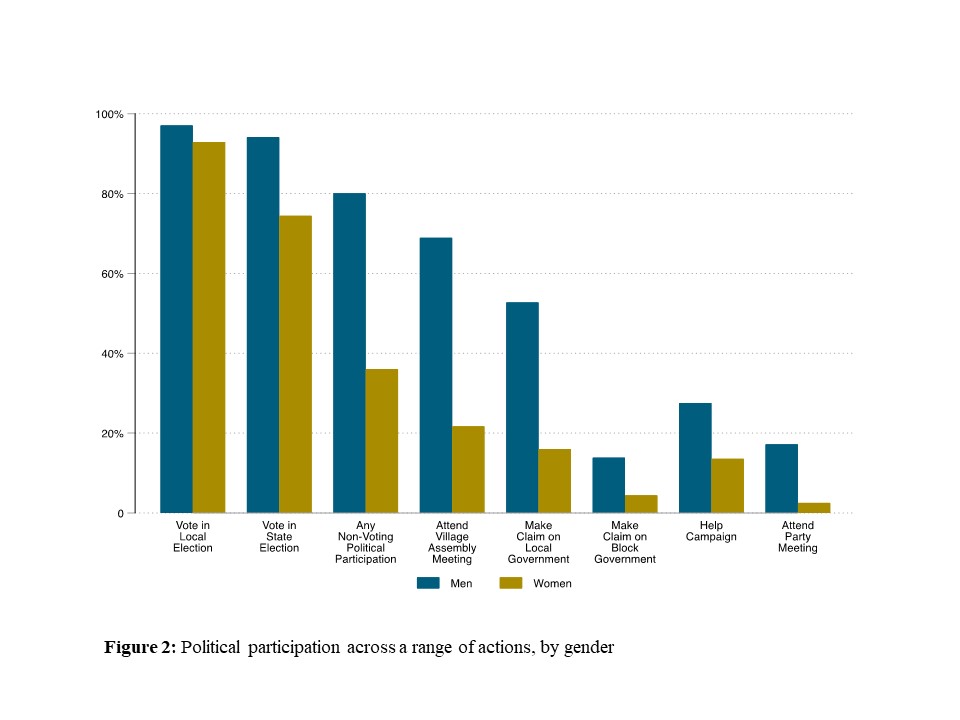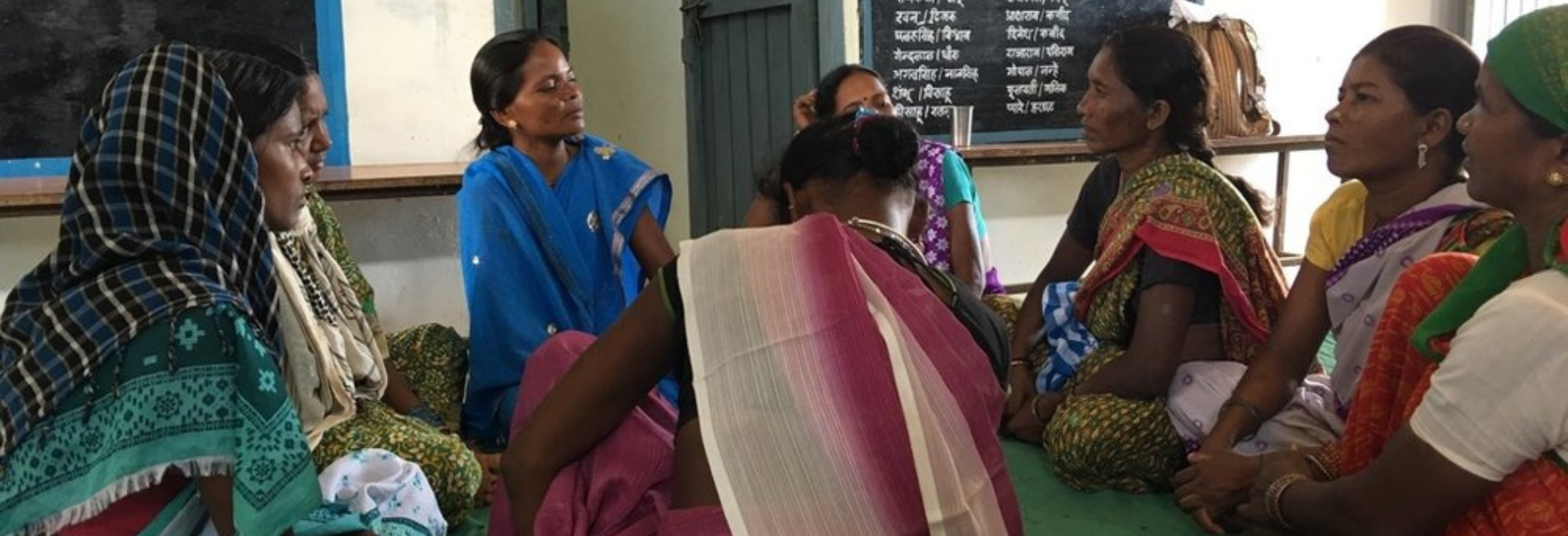Does Women’s Electoral Turnout Imply Their Political Agency?
For decades the gender turnout gap has been a focus of concern and inquiry across South Asia: why do women turn out to vote at substantially lower rates than men? Since the 1960s, the gender turnout gap in India has ranged from 5 to 15 percentage points, sitting at 8.4 percent as recently as 2004. And even as of 2018, the gender turnout gap in Pakistan’s general election was 9.1 percent. Yet recent headlines in India provide a flare of hope, highlighting how, for the first time in India’s democratic history, women are turning out to vote at higher rates than men.
While these positive swings most certainly indicate improving trends in women’s political inclusion, should we see the lack of a gender gap in turnout as indicative of women’s political agency? My recent research in rural India suggests maybe not. To evaluate this question, I conducted a series of qualitative and quantitative interviews with women in rural Madhya Pradesh about their voting behavior and political participation. What I systematically learned was that many women, even those who showed up to the ballot box on election days, lacked complete agency over their political decisions.
Political agency refers to the ability to act in accordance with one’s own interests without coercion or resistance. The study of women’s agency has deep roots in South Asia, gaining global traction through the proliferation of a focus on women’s empowerment or, as defined in a key piece by Naila Kabeer, ‘the process by which those who have been denied the ability to make strategic life choices acquire such an ability'. The aim of women’s political empowerment is, therefore, to ensure women’s political agency.
Analyzing survey data from 1,725 men and women (all adults residing in two villages), the purple bars in Figure 1 show the share of men and women who report themselves as being most influential in their voting decisions: 62% of male, but only 45% of female voters state they have agency over their voting choices. It is clear that a majority of women do not express political agency, but what is more interesting is that this also applies to a large number of men. In fact, young men under the age of 40 report roughly the same rates of vote agency as women. However, 85% of men over the age of 40 report voting agency.

Household Political Coordination
Why do women (and young men) have such low rates of political agency? The answer seems to lie in the way that households make political decisions. Women’s lives are shaped by the institutions within which they operate, starting at the most micro level, the household. I argue that women’s political behavior is defined by an institution I identify as household political coordination. Instead of acting as independent agents, most households make political decisions jointly. Through coordinated political behavior, households - principally heads of households - are best able to maximize their spoils from politics. In 75% of the interviews I conducted with women and 67% of those with men, respondents stated that their households always vote as a unit even when they disagree with the household’s preference. When households coordinate political behavior, women’s interests and voices are often suppressed.
Coordinated political behaviour is valuable because it improves the ability to advocate for the household’s interests, while simultaneously affording households’ decision-makers the chance to negotiate benefits in exchange for their respective household’s support. Household coordination is, therefore, both a rational response to a system of service delivery that privileges households as an institution, and an irrational consequence of within-household coercion. This is reinforced by strategic politicians, who benefit from the electoral mobilization that household political coordination can facilitate. Patronage and responsiveness are more easily delivered to a household than to individuals separately.
The subordination of women’s voices is most clearly seen when evaluating patterns of political behavior. Household political coordination is likely to yield high rates of electoral participation from both men and women in the household given its strategic value (as discussed above). Outside of elections, it is expected to yield low rates of political participation among women (and younger men). This is because of decreasing marginal returns to additional household participation that instead incentivize a household’s division of political labor. This puzzle of participation is clear in Figure 2. While both men and women vote at high rates, only men participate in politics in between election days.

Household coordination implies that women are often subjects, principally of their households, as opposed to agents and this is particularly likely in places where gender inequality is pervasive. The coordination of women’s political behavior with the household is likely to lead to an under-representation of their interests and the perpetuation of gender inequalities in political institutions. In her study of intrahousehold political decision-making, Sarah Khan demonstrates the extent of this phenomenon, showing that in gender unequal environments, it is precisely the women with the most distinct preferences within the household who are the least likely to express their preferences when asked.
Breaking the Patriarchal Household
When will women become agents over their own political decisions? If, as I have suggested, the constraint to women’s political agency is the nature of household political decision-making, then it stands to reason that autonomy from the household is likely to foster greater political agency and, ultimately, political participation. Comparing women within villages, I find that women who have a high degree of autonomy from their households, as measured based on the relative importance of the family within their political network, are ten percentage points more likely to participate in politics in between elections.
To probe this idea further, I studied the impact of participation in women’s microcredit groups on women’s political agency and political participation. Such microcredit groups, called Self-Help Groups in India, offer women a regular space to convene outside of the home and often involve informal discussion of topics such as positions for public office. I show that participation in these groups doubles women’s likelihood of political participation. I further find that it reduces their likelihood of coordinating their political behavior with their households, and increases their agency over political decisions.
Ultimately, these data highlight the need to probe into the mechanics of women’s political agency. A deeper understanding of who benefits from the suppression of women’s political agency - and, in some cases such as voting, from the elevation of their political participation - can better reveal actual constraints to their political inclusion. While recent increases in women’s voting behavior are likely an imprecise representation of the present status of women’s political inclusion, they may offer a beacon of positive change to come. As women gain autonomy from their households, they are likely to gain political agency. And as they gain agency, their voices are more likely to be elevated and heard.
Soledad Prillaman, Assistant Professor of Political Science, Stanford University
Mahbub ul Haq Research Centre at LUMS
Postal Address
LUMS
Sector U, DHA
Lahore Cantt, 54792, Pakistan
Office Hours
Mon. to Fri., 8:30 a.m. to 5:00 p.m.









